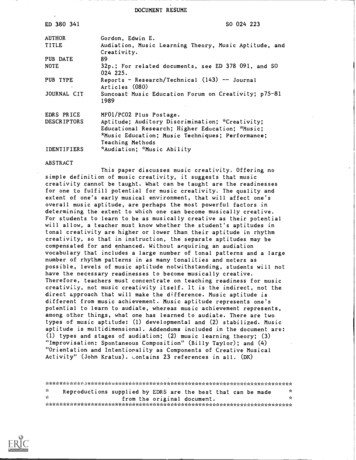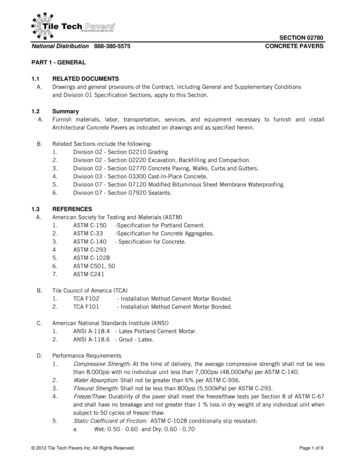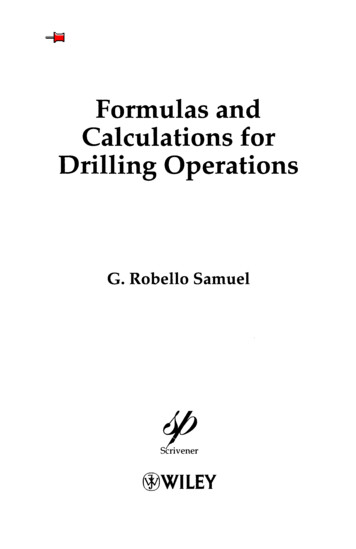
Transcription
DOCUMENT RESUMEED 380 341SO 024 223AUTHORTITLEGordon, Edwin E.Audiation, Music Learning Theory, Music Aptitude, andCreativity.PUB DATENOTE8932p.; For related documents, see ED 378 091, and SOPUB TYPE024 225.ReportsResearch/Technical (143)Articles (080)JOURNAL CITSuncoast Music Education Forum on Creativity; p75-81Journal1989EDRS PRICEDESCRIPTORSIDENTIFIERSMF01/PCO2 Plus Postage.Aptitude; Auditory Discrimination; *Creativity;Educational Research; Higher Education; *Music;*Music Education; Music Techniques; Performance;Teaching Methods*Audiation; *Music AbilityABSTRACTThis paper discusses music creativity. Offering nosimple definition of music creativity, it suggests that musiccreativity cannot be taught. What can be taught are the readinessesfor one to fulfill potential for music creativity. The quality andextent of one's early musical environment, that will affect one'soverall music aptitude, are perhaps the most powerful factors indetermining the extent to which one can become musically creative.For students to learn to be as musically creative as their potentialwill allow, a teacher must know whether the student's aptitudes intonal creativity are higher or lower than their aptitude in rhythmcreativity, so that in instruction, the separate aptitudes may becompensated for and enhanced. Without ar,quiring an audiationvocabulary that includes a large number of tonal patterns and a largenumber of rhythm patterns in as many tonalities and meters aspossible, levels of music aptitude notwithstanding, students will nothave the necessary readinesses to become musically creative.Therefore, teachers must concentrate on teaching readiness for musiccreativity, not music creativity itself. It is the indirect, not thedirect approach that will make the difference. Music aptitude isdifferent from music achievement. Music aptitude represents one'spotential to learn to audiate, whereas music achievement represents,among other things, what one has learned to audiate. There are twotypes of music aptitude: (1) developmental and (2) stabilized. Musicaptitude is multidimensional. Addendums included in the document are:(1) types and stages of audiation; (2) music learning theory; (3)"Improvisation: Spontaneous Composition" (Billy Taylor); and (4)"Orientation and Intentionality as Components of Creative MusicalActivity" (John Kratus). Lontains 23 references in all. *********************Reproductions supplied by EDRS are the best that can be madefrom the original ******************************
000enAudiation, Music Learning Theory,Music Aptitude, and CreativityEdwin E. GordonU.S. DEPARTMENT OF EDUCATION0,ce of Educsbonai RsolarCh and ImprovementEDUCATIONAL RESOURCES INFORMATIONCENTER (ERIC)11Tts document has been reproducedeareserved Irom the c.erson of orgentzationongmahng4O MrhOr Changes have Peen made to Improvereproduction qualityPolls 01 view or oCxn.Oal stId.n th.SCIOC.ment do not necessarily ,OP,03001 ethclalOERI position or policy'PERMISSION TO REPRODUCE THISMATERIAL. HAS BEEN GRANTED BYe-Icirbei-L EA'a,TO THE EDUCATIONALRESOURCESINFORMATION CENTER (ERIC)BEST COPY P6 ALABLE2
Audiation, Music Learning Theory,Music Aptitude, and CreativityEdwin E. GordonIt seems natural that when one thinks of the arts, he thinks of creativity, and whenonethinks of creativity, he thinks of the arts. Thus it isnot surprising that when one thinks of music,which is one of the arts, he thinks of creativity.That has advantages and disadvantages. Oneof the advantages is that music is immediatelytreated with awe in the minds of many sensitive,thoughtful, and influentialpersons. One of the disadvantages isthat music teachers areexpected by those persons to know how to teach theirstudents to be musically creative. Toteach a student to be musically creative is a complex, if not an impossible, undertaking.Thereasons are varied. Those reasons are best understood by exploringthe nature of audiation,music learning theory, and music aptitude.My reasons for believing that music creativitycannot be taught should becomeincreasingly clear as I explain the nature of audiation,music learning theory, and musicaptitude. I will expound my belief that a studentcan be taught only to acquire the necessaryinformation that will enable him to become musicallycreative to the extent that his potential willallow. I shall begin with audiation, move to music learningtheory, describe music aptitude, andthen conclude by explaining how all of them mustserveas readinesses for music creativity,and how they collectively give rise to music creativity.AudiationA person audiates when he can hear andcomprehend music for which the sound is notphysically present. Audiation is not imitation.For example, I shall sing a short song withoutwords, and then I would like you to sing it back to me.It is apparent that you imitated thesong, but I am not sure that you audiated it. Did you know that thesong is in lydian tonality andthat the meter of the song changed back and forthbetween triple meter and duple meter? Ifyou did not, you were imitating but not audiating thesong, because you did not comprehendwhat you were hearing. You simply learned thesong by rote. Take another example. All ofyou, of course, can audiate Happy Birthdayas being in major tonality and in triple meter. Areyou able to audiate Happy Birthday, however, inharmonic minor tonality and duple meter? Ifnot, your ability to audiate is limited.Neither is audiation recognition. For example,most, if not all, of you would recognizethe Mozart Symphony in 0 Minor upon hearingit, but would you be able to audiate all of themajor themes of the symphony before,or even after, you heard the work? If not, you arecapable of recognizing the symphony butnot of audiating it. If I am asking you to do thingswhich you cannot do, do not be too criticalof yourselves. Remember, most of the musicinstruction you received in elementary school, inhigh school, and at the college and universitylevels emphasized imitation and recognitionat the expense of audiation. Rarely, if ever, wasaudiation taught as a natural follow-up toimitation. At this point in the discussion I might askyou to give some preliminary thought to the question:Is it possible for one to become musicallySuncoast Music Education ForumPage 75
creative if he cannot audiate, even though he may be able to imitate andrecognize music?Although imitation is the necessary readiness for learning how to audiate, audiationissignificantly different from imitation as well as from recognition. Moreover, audiation isnot thesame as memorization. That an instrumentalist or a vocalistmay perform in concert does notmean that either is necessarily audiating what he is performing. Manyyoung, and some moremature, musicians simply have memorized what they perform withoutaudiating what theyperform. They have memorized the order and sequence of themusic that they have learnedby rote without comprehending it. Of course one can learnto memorize by reading notationas well as by listening to someone else perform.As a result of the foregoing distinctions made among audiation,imitation, recognition,and memorization, perhaps many of you may be beginning to makea comparison between theroles of audiation and notation in music education. Unlessone can audiate what is seen innotation before he produces sound on an instrumentas dictated by the notation, what he isreading will have only theoretical meaning for him. Unfortunately he willbe engaging in the actof attempting to take theoretical meaning from thenotation ratherthan to give musical meaningto the notation. Without an idea of what the music shouldsound like before he reads it innotation, he cannot learn much about the music itself from thenotation. Notation can only helpone recall what he can already audiate. Moreover,one cannot learn to audiate notationallyunless he has first learned to audiate. To attempt to teachmusical creativity by using notationto one who cannot notationally audiate, or even audiate, is thehandmaiden of folly.Before leaving the topic of audiation, I should mention, althoughit is probably obvious,that there are various types and stages of audiation.Types of audiation include listening tomusic, reading music, writing music, performingmusic from recall, and improvising andperforming music creatively. The stages of audiationare not so clear cut. Though the stagesare hierarchical, two or more of the stages usually are concurrent.Consider, as an example,the stages of audiation that one ideallypasses through when he listens to music. First, soundis audiated. Second, the sounds are grouped inaudiation into tonal patterns and into rhythmpatterns. Third, the tonality and the meter of the tonalpatterns and rhythm patterns areaudiated. Fourth, at the same time that the tonal patterns, rhythmpatterns, tonality, and meterof the music heard just seconds earlier are beingsustained in audiation, the forthcomingsounds of the music are being audiated.Fifth, tonal patterns, rhythm patterns, tonalities,meters, modulations, style, and form, to name only a few of the dimensionsof music, arerecalled from music that was heard days, weeks, months,or even years ago to help interpretthe music which is currently being heard. Sixth, what willbe heard next in the music is beingpredicted in audiation at the same time as whathas been heard in the music is being sustainedin audiation. (See Addendum A for more detailedinformation about the types and stages ofaudiation.)It might be helpful to clarify the stages of audiationwith an analogy. Consider language.You have been listening to me speak for a few minutesnow. Think about how and in whatsequence you are giving meaning to what I am saying. Youare not giving meaning to whatI am saying at the moment I say it. Youare giving meaning to what I am saying by audiatingwhat I said just a fraction of a second after I saidit. To that extent, there is no present; thereis only a past and a future. To be able to give meaningto what I am saying, you need to sustainSuncoast Music Education ForumPage 764
in audiation and to think about what Ihave said as you are hearing what I am saying. As youare sustaining in audiation and thinking about whatyou have heard and what you are hearing,you are recalling words and phrases that you have heardat previous times to assist you inthinking about and giving meaning to whatyou are not hearing me say. Finally, while you aredoing all of that, you are thinking about andpredicting what you believe I will be saying next.Music Learning TheoryMusic learning theory is simply an account of how we learn whenwe learn music. (SeeAddendum B for more detailed information aboutmusiclearningtheory.)Although music isnot a language, we learn music in thesame way that we learn a language. Audiation is to musicwhat thinking is to a language. Pretend thatyou are listening to a piece of music. Considerhow you give meaning to that music and thesequence in which you give meaning to that music.You give meaning to musical soundsby organizing them into tonal patterns and rhythmpatterns in terms of one or more tonalities andmeters. Tonal patterns and rhythm patterns areto music what words are to language, and tonalityand meter are to music what syntax is tolanguage. The more tonal patterns andrhythm patterns that you can audiate in differenttonalities and meters, the more meaning you can bring inaudiation to the music that you arehearing. That is, the more tonal patterns and rhythmpatterns that you have in your audiationvocabulary, the better meaning you can bringto the music that you are listening to. You willnot only interpret better what you have heard,but also you will understand better why what youmay or may not have predicted to come next in the musicdoes or does not make sense. Justas the number of words one can think with is highlycorrelatedwith language aptitude, thenumber of tonal patterns and rhythm patterns thatone can audiate is highly correlated withmusic aptitude.In language, one does not retain in thoughtall words that he has heard spoken in alecture. In music, one does not retain in audiationall tonal patterns and rhythm patterns thathe has heard performed in a piece of music.Only the essential patterns are retained inaudiation. The summarizationand organization in thought of the essential words intosentences provide the basis for syntactical linguisticmeaning. Likewise, the summarizationand organization in audiation of the essentialtonal patterns and rhythm patterns into phrasesprovide the basis for syntactical musical meaning.The fundamental premise of music learningtheory is that one cannot efficiently oradequately give meaning to music that he is listeningto,performing through recall or notation,or performing through improvisation or creativityunless he can audiate. If that is the case, itfollows that one cannot be taught to createor improvise music with any degree of sophisticationunless he can audiate. And if that is thecase, it follows that one must teach himself how tocreate and improvise with tonal patternsand rhythm patterns that he has in his audiationvocabulary in the same way that one must teachhimself how to develop sentences with wordswhich he has in his thinking vocabulary.In a word, the act of music creativity and improvisationis the act of audiating familiartonal patternsand rhythm patterns and then reorganizing theminto an unfamiliar order and sequence.Unless one can think about what he is going5to say in a novel way before he says it, allSuncoast Music Education ForumPage 77
that he may produce is an endless stringingtogether of "like," "you know," "I mean," and "OK,"each of which will be made to serveas a noun, verb, adjective, or adverb. There is a similarsituation in music. Unless one can audiateperforms it or even attempts to notate it, what he is going to create and improvise before heall that may be heard at best are the mechanics ofscales and arpeggios, and at worst,mere exploration.In the foregoing, I have not restrictedmy remarks to creativity. I have also talked aboutimprovisation. I believe that creativity and improvisationarr, related to each other in the formof a continuum. The fewer restrictionsthere are, the more creativity takes place. The morerestrictions there are, the more improvisationtakes place. Thus improvisation is a limited typeof creativity. For example, one isencumbered by few restrictions ,then he begins to create apiece of music. Once the tonality andmeter, and perhaps the melodic range and the complexityof rhythm are decided upon to suit the intendedperformer or performers, the composer isrelatively free to create what he pleases. Onthe other hand, when one improvises a variation,he follows a melodic line, and if oneimprovises in a jazz style, he typically follows a series ofchord progressions.A more extensiveaudiation vocabulary cf tonal patterns and rhythm patterns is requiredto improvise than to create. That isparticularly so in the sixth stage of audiation, in which onepredicts what will be heard next. Inimprovisation, and to a more limited extent in creativity,rather than actually predicting, one isselecting from a number of patterns in his audiationvocabulary the pattern or patterns whichmight most logically and reasonably follow all of thepatterns that have thusperformed.far been performed, and, in particular, thepattern that is beingMusic AptitudeBefore engaging in a discussion of musicaptitude, I feel that I must make a fewpreliminary remarks to put you at ease.I know that when many of you hear the term "musicaptitude," you immediately think of invalid andto deny music instruction to enthusiastic threatening music aptitude tests which are usedstudents who demonstrate low levels of musicaptitude. That should not be the case at all.There are valid music aptitude tests which arerather enjoyable to take. Moreover,the purpose of a well-designed music aptitude test is notto deny anyone music instruction. Thepurpose of a valid music aptitude test is to improvemusic instruction by teaching to students'individual musical differences. When a teacherteaches to students' individual musicalneeds in terms of the students' potential to learnmusic,students with low music aptitude donot become frustrated and frightened, andstudents withhigh music aptitude do not becomebored and complacent. In the best tradition ofmusiceducation, music aptitude tests are used to improve musicinstruction.Music aptitude is different from musicachievement. Music aptitude represents one'spotential to learn to audiate, whereasmusic achievement represents, among other things,what one has learned to audiate. Thereare many aspects of music aptitude: it is normallydistributed; just as there is no one withoutsome degree of intelligence, so there is no onewithout some degree of music aptitude;music aptitude is not correlated with race, religion,nationality, or social status; and highly intelligentpersons are not necessarily highly music norSuncoast Music Education ForumPage 786
are highly musical persons necessarily intelligent.I will limit myself, however, to two conceptsthat are relevant to our top;,.; today.First, there are two types of music aptitude: developmentaland stabilized. From thetime achild is born, if not before birth, until he isapproximately nine years old, his music aptitudeis a product of both nature and nurture. He is bornwith a certain level of music aptitude, whichmay rise or fall, depending upon the quality of his music environment.The younger he is, thegreater the effect his environment will have on his music aptitude. Becausea child's level ofmusic aptitude is subject to change, dependingupon his musical surroundings, until he is nineyears old, his music aptitude during that time is definedas developmental. After a child is nineyears old, his music aptitude becomes stabilized. His musicalenvironment will no longer haveany effect on his level of music aptitude. That is not tosay that a child cannot achieve in musicafter he is nine years old. What it means is thata child who is older than nine will not be ableto achieve in music any higher than his level of stabilizedmusic aptitude will allow. It followsthat a child's early exposure to music may well be theextent to which he will be able to create musically most important determining factor of thewhen he is older.Second, music aptitude is multidimensional. Asan example, ask yourself if your tonalaptitude is higher than your rhythm aptitude or ifyour rhythm aptitude is higher than your tonalaptitude. You would be a rare person if in factyour tonal aptitude and rhythm aptitude are atthe same level. If you have a high tonalaptitude, you are probably average or low in rhythmaptitude. If you have a high rhythm aptitude,To make matters more complex, in my initial you are probably average or low in tonal aptitude.research into the nature and description of musicaptitude more than thirty years ago, I identified no fewer than thirty-twodifferent musicaptitudes. Music creativity and music improvisationwere two of those stabilized musicaptitudes. The typical person has a music aptitudeprofile in which creativity aptitude andimprovisation aptitude are at different levels, and eachis at a different level from his tonalaptitude and rhythm aptitude levels.SummaryIt is clear that I have no simple definition of musiccreativity. It is clear, however, thatI believe that music creativity cannot be taught.What can be taught are the readinesses forone to fulfill his potential for music creativity.Moreover, the quality and extent of one's earlymusical environment, which will affect one'soverall music aptitude, is perhaps the mostpowerful factor in determining the extent to whichone can become musically creative. For astudent to learn to be as musically creativeas his potential will allow, a teacher must knowwhether his aptitude in tonal creativity ishigher or lower than his aptitude in rhythm creativity,so that in instruction his separate aptitudesmay be compensated for and enhanced.It is true that unless one learns early to feel free whilestill following a discipline, he willfind it difficult to emerge at a later timeas a creative musician. There is little doubt in my mindthat to be able to create is one thing andto be able to create in a given style is another. Withoutconstant early exposure to a given style, thelikelihood that one will be able to create in that styleis questionable. Nevertheless, I do notwant to give the impression that music aptitude andthequality and quantity of one's musical environmentare the only factors that play important rolesSuncoast Music Education Forum7Page. 79
in music creativity. I hope that Ihave emphasized that without acquiring an audiationvocabulary that includes a large number of tonalpatterns and a large number of rhythmpatterns in as many tonalities and metersaspossible,levels of music aptitude notwithstanding,one will not have thenecessary readinesses to become musically creative. So I say we mustconcentrate on teaching readiness for musicindirect, not the direct, approach that will makecreativity, not music creativity itself. It is thethe difference.Edison said that it took ninety-ninecreate the light bulb. I believe that it takes percent perspiration and one percent inspiration tomuch work and motivation on the part of the musicstudent, as well as on the part of themusic teacher, for the student to acquire an audiationvocabulary of tonal patterns and rhythmpatterns large and varied enough to form a foundationfor becoming a musically creativeartist. To that extent, perhaps there is nopure creativity atall. There may be only the continualrediscovery of eternal truths.Suncoast Music Education ForumPage 803
ReferencesBudd, Malcolm. (1985). Music and the Emotions. London:Rout ledge and Kegan Paul.Clifton, Thomas. (1983). Music as Heard. New Haven: YaleUniversity Press.Deutsch, Diana. ed. (1986).litaE. New York: Academic Press.Dowling, W. Jay and Dane L. Harwood. (1986). Music as Cognition. New York: AcademicPress.Gordon, Edwin E. (1986). The Nature. Description. Measurement.and Evaluation of MusicAptitudes. Chicago: GIA.Gordon, Edwin E. (1986). Musikalische Begabung: Beschaffenheit,Beschreibung. Messung,and Bewertuna. trans. Michael Roske. Mainz: Schott.Gordon, Edwin E. (1989). Learning Sequences in Music: Skill.Content. and Patterns. FifthEdition. Chicago: GIA.Green, Barry and W. Timothy Gallwey. (1986). The Inner Gameof Music. Garden City, NewYork: Anchor Press.Hargreaves, David J. (1986). The Developmental Psycholoay of Music. Cambridge: Cambridge University Press.Howell, Peter, Ian Cross, and Robert West. eds. (1986). Musical Structureand Cognition. NewYork: Academic Press.Husserl, Edmund. (1965). Phenomenoloay. and the Crisis of Philosophy.trans. Quentin Lauer.New York: Harper and Row.Rowell, Lewis. (1983). Thinking About Music. Amherst: The University of MassachusettsPress.Sloboda, John. (1986). The Musical Mind. Oxford: Clarendon Press.Vygotsky, L. S. (1967). Thought and Language. ed and trans. EugeniaVakar. Cambridge: MIT Press.Hauffman and GertrudeWhorf, Benjamin Lee. (1956). Language. Thought. and Reality.Boston: The MassachusettsInstitute of Technology.aSuncoast Music Education ForumPage 81
Addendum A*Types and Stages of AudiationType 1: The most common type of audiation takes place as we are listening to music.When we listen to familiar and unfamiliar music, we audiate familiar and unfamiliar tonalpatterns and rhythm patterns, and then connect them in order to give syntacticalmeaning tothe music. The same procedure takes place as we listen tosomeone speak. We attend to theindividual words, put them together into phrases and sentences, and then givesyntactical andgrammatical meaning to w, at is being said. In speech we audiate only those words that areessential to the meaning of what is being said and dismiss the unessential words that we hear.In music we audiate only the essential pitches of a tonal pattern and the essential durations(note values) of a rhythm pattern. We dismiss the pitches and durations,perhaps even entirepatterns, that are not essential for giving syntactical meaning to the music. Because thepatterns that we are audiating include only essential pitches and durations, theyare abbreviations of thy: complete patterns that we are hearing. Moreover, thepatterns of essential pitchesand durations that we are audiating are not exactly thesame as the complete patterns that weare seeing in notation.Essential pitches and durations in a pattern are those which establish the function of apattern and contribute to the syntactical meaning of the music.Essential pitches in a tonalpattern may indicate, for example, a tonic or a dominant function in major or minor tonality.Essential durations in a rhythm pattern may indicate, for example, a macro and micro beat ordivision and elongation function in duple meter or triple meter.Unessential pitches in a tonalpattern may be consecutive or non-consecutive repeated pitches, andunessential durationsin a rhythm pattern may be durations which are divisions of microbeats or elongations of macrobeats.Type 2: The second type of audiation takes placeas we are reading the notation offamiliar and unfamiliar patterns in familiar and unfamiliar music.It is called notational audiation.We may read silently, or we may perform what we read withour voice or on an instrument, orwe may read as someone else performs the music. To read is to audiate throughnotation whatis to be performed before it is performed. When readingthe notation of familiar and unfamiliarmusic, we should be able to organize and audiate familiarand unfamiliar patterns from theseries of symbols that we see in notation without the aid of auralperception. Unessentialpitches and durations in the tonal patterns and rhythm patterns that we are reading areunconsciously excluded from the patterns of essential pitchesand durations that we areaudiating as we are reading.Type 3: A third type of audiation takes place as we are writing from dictation familiar andunfamiliar patterns in familiar and unfamiliar music. It is alsonotational audiation. When writingfamiliar and unfamiliar patterns in familiar and unfamiliarmusic from dictation, we audiate whatwe have aurally perceived. Then we represent what is being audiated withsymbols in notation.Although we audiate only the essential pitches anddurations of the tonal patterns and rhythmpatterns that are to be written, we unconsciously place the unessentialpitches and durationsof the tonal patterns and rhythm patterns in thecomplete patterns as they are being written.Suncoast Music Education ForumPage 8210
Type 4: A fourth type of audiation takes place as we are recalling without the aid ofnotation familiar tonal patterns and rhythm patterns in familiar music, and performing themsilently, vocally, or on an instrument. Each of the familiar patterns in the familiar music that weare organizing and audiating in recall guides us in organizing and sequentially recalling inaudiation the remaining familiar patterns in the familiar music. The process continuesthroughout that piece of familiar music. We do not recall a familiar piece of music as a resultof memorizing it. We recall a familiar piece of music by organizing and sequentially audiatingfamiliar tonal patterns and rhythm patterns of essential pitches and durations and byunconsciously placing unessential pitches and durations of the tonal patterns and rhythmpatterns in the complete patterns as they are being recalled in audiation. When weareperforming, vocally or instrumentally, familiar musicthat we are recalling in audiation,muscularactivity, such as fingering and vocal cord movement, may aid us in our organization and recall.Type 5: A fifth type of audiation takes place as we are writing familiar patterns in familiarmusic that we are organizing and recalling through audiation. It is also notational audiation.Each of the familiar patterns in the familiar music thatwe are organizing and audiating in recallguides us in organizing and sequentially recalling in audiation theremaining familiar patternsin the familiar music. The process continues throughout the piece of familiar music.As in Type4, where familiar music is recalled but not written, when the music is written it is not recalledas a result of memorizing it. Although we audiate only the essential pitches and durations ofthe tonal patterns and rhythm patterns that are to be recalled and written,we unconsciouslyplace the unessential pitches and durations of the tonal patterns andrhythm patterns in thecomplete patterns as they are being recalled and written.Type 6: A sixth type of audiation takes place as we are creating or improvisingunfamiliarmusic, using both familiar and unfamiliar patterns, and performingit silently, vocally, or on aninstrument. Each of the familiar and unfamiliar patterns in the unfamiliar music that we arecreating or improvising in audiation guides us in recalling in audiation familiarpatterns and inorganizing and recalling in audiation familiar and unfamiliar patterns. Theprocess continuesthroughout the piece of unfamiliar music. Unessential pitches and durationsare unconsciouslyplaced in the complete tonal patterns and complete rhythm patternsas the unfamiliar musicis being created and improvised in audiation.Type 7: A seventh type of audiation takes place as we are writing unfamiliar music, usingboth familiar and unfamiliar patterns, that we have just recently01 are presently creating or improvising. It is also notational audiation.When we are writing music that we are creating orimprovising, each of the familiar and unfamiliar patterns in theunfamiliar music that we arecreating or improvising in audiation guides us in recalling in audiation familiarpatterns and inorganizing and recalling in audiation familiar and unf
TITLE Audiation, Music Learning Theory, Music Aptitude, and. Creativity. PUB DATE. 89. NOTE 32p.; For related documents, see ED 378 091, and SO. 024 225. PUB TYPE. Reports. Research/Technical (143) Journal. Articles (080) JOURNAL CIT Suncoast Music Education Forum on Creativity; p75-81. 1989. EDRS PRICE MF01/PCO2 Plus Postage.










